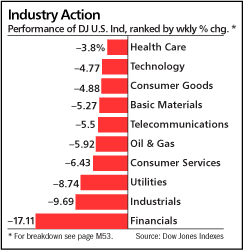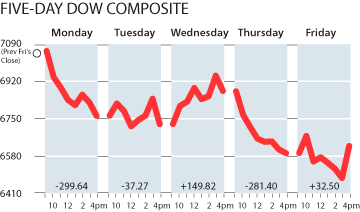
From "The Street"
An economic indicator that uses railroad shipments to gauge the future sees few signs of hope, with one notable exception -- the railroads themselves are doing great.
"I don't see any parting in the clouds," says Drew Robertson, who heads New York-based transportation consulting firm Atlantic Systems. "In every economically sensitive area, I see weakness. There's nothing to indicate that six months from now we will be coming out of a recession."
"I don't see any parting in the clouds," says Drew Robertson, who heads New York-based transportation consulting firm Atlantic Systems. "In every economically sensitive area, I see weakness. There's nothing to indicate that six months from now we will be coming out of a recession."
Robertson tracks railroad shipments on a Web site that's updated weekly. Of the eight principal products shipped by rail, the latest statistics show year-over-year declines in six: food, forest, metals, coal, autos and intermodal.
Only grain and chemicals show advances, a result, says Robertson, of "a boom in the agricultural economy" due to ethanol production and export programs. "It has nothing much to do with economic fundamentals," he says.
The outlook for construction is particularly glum. "There is continuing and consistent weakness, with little shipping in lumber or wallboard or crushed stone or gravel that is used for foundations, and there is not even a baseline yet as far as building up rail traffic and demand in the economy," he adds. "Commodities used in construction have been weak for a year and a half, and I don't yet see them coming back from the dead."
Meanwhile, the decline in intermodal traffic, which reflects the movement of imported Asian products from West Coast ports, indicates that "a very large part of our appetite for imports has gone down and stayed down for the past year."
Railroads are the nation's leading long-distance carrier of bulk commodities, including autos, forest products, chemicals, grains and containers, and a leading carrier of metals. The metal and auto shipments supply the auto industry, while forest products reflect the housing industry. Because railroads haul products well in advance of the time they are consumed, they are commonly seen as leading indicators.
Still, "fewer and fewer people use railroad data," says Mark Vitner, senior economist for Wachovia. "Fifteen years ago, I looked at it all the time, but today it doesn't give us a complete picture because so much more of the U.S. economy is services."
Additionally, Vitner questioned whether railroad data confirm a recession, suggesting the data actually indicate that construction has slipped and that businesses are reducing inventories. The latter trend could continue through the second quarter, he says. But "inventories are already so low that it's hard to imagine a scenario where a pulldown in inventories would pull GDP into a slowdown."
Among the products shipped by rail, the best economic indicator may be chemicals, Vitner says, because they go into every product, from shampoo to BlackBerrys, and because they represent an area in which railroads have lost little market share to trucks. So the rise in chemical shipments may be significant.
In any case, railroads themselves remain profitable, and investors are taking note. Since Jan. 1, 2007, while the S&P 500 index has dropped nearly 5%, the nation's four principal railroads have all been rising.
CSX(CSX - Cramer's Take - Stockpickr) and Union Pacific (UNP - Cramer's Take - Stockpickr) have both risen more than 33%. Burlington Northern Santa Fe(BNI - Cramer's Take - Stockpickr) is up nearly 20%, and Norfolk Southern(NSC - Cramer's Take - Stockpickr) is higher by about 8%.
Looking ahead, Burlington Northern assumes 2008 unit volume will be flat to up slightly, but demand will remain strong. "Pricing will be firm but slightly less robust than in 2007, even with general uncertainty about the economy," said spokesman Pat Hiatte. The company has told analysts that low double-digit EPS growth is achievable, with freight revenue growth in the high single digits.
Meanwhile, Norfolk Southern says it anticipates volume and revenue increases this year. "The weak dollar and strong global demand should bolster exports, partially offsetting the slowdown in domestic demand," Executive Vice President Donald Seale said last month on an earnings conference call. He said 2008 pricing gains should average 4%.


No comments:
Post a Comment